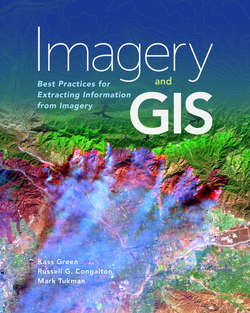Читать книгу Imagery and GIS - Kass Green - Страница 7
На сайте Литреса книга снята с продажи.
Chapter 1 Introduction Why Imagery and GIS?
ОглавлениеImagery—it allures and fascinates us; its measurements inform us. It draws us in to explore, analyze, and understand our world. First comes the astonishment of its raw beauty—the enormity of a hurricane, the stark glaciers in Greenland, the delicate branching of a redwood’s lidar profile, a jagged edge of a fault line in radar, the vivid greens of the tropics, the determined lines of human impact, the rebirth of Mount Saint Helens’ forests, the jiggly wiggly croplands of Asia and Africa, the lost snows of Kilimanjaro. Each image entices us to discover more, to look again and again.
Then we start to ask questions. Why do trees no longer grow here? Can trees grow here again? How much has this city expanded? Will the transportation corridors support emergency relief? Why did this house burn while the one next door is untouched by flames? What crops flourish here? Will they produce enough food to feed the people of this region? Why has this landscape changed so dramatically? Who changed it? When we bring imagery and GIS together we can answer these questions and many more. By combining imagery and GIS, we can inventory our resources, monitor change over time, and predict the possible impacts of natural and human activities on our communities and the world.
This book teaches readers about the many ways that imagery brings value to GIS projects and how GIS can be used to derive value from imagery. Imagery forms the foundation of most GIS data. Whether it be a map of transportation networks, elevation contours, building footprints, facility locations, vegetation type, or land use, the information in most GIS datasets is derived primarily from imagery. Alternatively, GIS allows us to more efficiently and effectively derive information from imagery. Organizing imagery in a GIS brings the power of spatial information management and analysis to imagery.
The purpose of this book is to unlock the mysteries of imagery, to make it readily usable by providing you with the knowledge required to make informed decisions about imagery. More than just an overview of remote sensing technology, this book takes a hands-on, decision-focused approach. Each chapter evaluates practical considerations and links to online interactive examples. The book also includes multiple real-world case studies that highlight the most effective use of imagery and provide advice on deciding between alternative image sources and approaches. The book provides guidance on
1 1.choosing the best imagery to meet your needs;
2 2.effectively working with and processing imagery;
3 3.efficiently extracting information from imagery; and
4 4.assessing, publishing, and serving imagery datasets and products.
